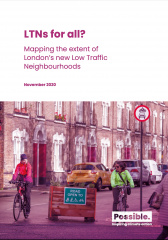LTNs for all? Mapping the extent of London’s new Low Traffic Neighbourhoods
Document types:
Document weight:
Document geography:
Geographical spread:
Low traffic neighbourhoods, or LTNs, are increasingly being used in London and other cities and countries to reduce through motor traffic in residential areas, aiming also to increase local walking and cycling. This report explains what LTNs are, what they look like, potential impacts and reasons for their introduction, and limits of this intervention. It then considers LTNs in London, and how equitably they are being introduced.
Specifically, we examine where in London LTNs have been put in place (between March and September 2020), and disparities between boroughs. In addition, we conduct demographic analysis of travel survey data comparing residents of residential streets (where LTNs are most likely to be implemented) and main roads/high streets. This compares four ‘protected characteristics’ under Britain’s Equality Act: age group, income group, ethnic group, and disability status. Across all groups we compared, around nine in ten Londoners live on residential streets. Differences were negligible in Inner London, with slightly more disparities in Outer London. While LTNs have the potential to benefit the majority of Londoners in all groups, it is important also to introduce measures that benefit Londoners living on the 5-10% of roads where LTNs may not be possible, particularly in Outer London. Encouragingly, a look at traffic levels around an early LTN implementation in Walthamstow Village also suggests that traffic trends on the nearby boundary roads were little different to broader London trends.
Our analysis of LTN locations shows a borough lottery. Ten boroughs have either introduced no LTNs during this time or (in two cases) introduced them briefly and then removed them. Boroughs lacking LTNs are more likely to be in Outer London, where motor traffic rebound (and hence impact on residents) is strongest. Some of these ten boroughs have overall high levels of deprivation, making this a missed opportunity to provide mobility and public space for those in most need. But all London boroughs contain poorer areas where homes are more crowded and fewer own cars, which might particularly benefit from/need LTNs.

